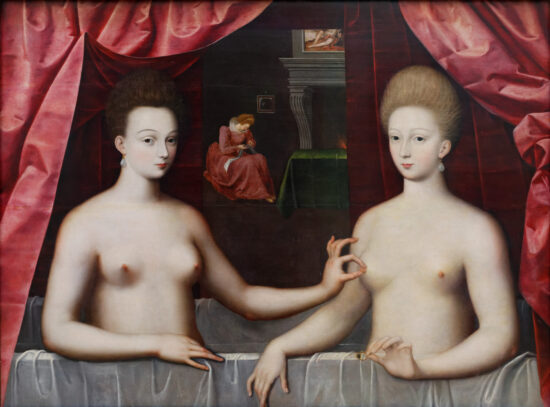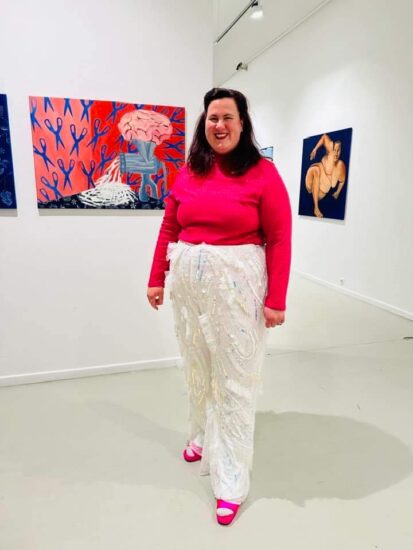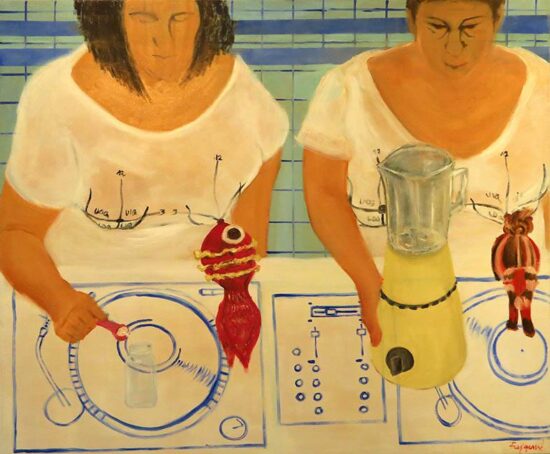Contributing author Caitlin Swindell is the Curator of Collections and Exhibitions at the Lowe Art Museum, University of Miami. She has held curatorial positions at the Denver Art Museum and the Museum of Contemporary Art (MOCA) Jacksonville, worked as an art consultant in Santa Fe, NM, and completed internships at various institutions, including the Museum of Fine Arts, Boston, the Smithsonian National Portrait Gallery, and the New Orleans Museum of Art.
Andrea Fajgerné Dudás (b. 1985) is an artist, contemporary painter, housewife, feminist, performance artist, and a mother of two. She is represented by Erika Deák Gallery in Budapest, Hungary. For more information, visit the artist’s website at https://fajgerne.com/.
This is Part 2 of an in-depth interview with the artist. To read Part 1, click HERE.
Caitlin: You have also created some performance-based work in relation to the Housewife series—using mops and making jam. Could you speak a little more on these performances. How do you go about creating them? What meanings or experiences do you hope viewers might gain from seeing them?
Andrea: The genre of Eat Art is mostly manifested as a happening, which interests me because I can interact with the audience, engaging them and pushing them out of their comfort zone while putting myself in an improvisational, unplanned situation.
In 2010, as a scholarship holder, I was introduced to Eat Art, which was taught as a separate subject at the University of Dresden. In addition, seeing Judy Chicago’s The Dinner Party installation live that same year was a defining experience. Then in 2013, I met Daniel Spoerri in person, had a conversation about art, and tasted his Green Paradise stew. In the same year, I met Eszter Agnes Szabó, with whom I have been actively working and thinking ever since. Since 2010, I have been creating Eat Art happenings regularly, practicing a kind of art therapy as I feed the audience symbolically while breaking them out of their everyday habits. It’s important to stress that I create events where I provoke the audience, and although I follow a planned scenario, I never know how the audience will actually react, or what will happen. Any happening I create can be repeated, but it will never be the same because it is influenced by the audience, the location, the time of year, and other actions that take place during the performance. I am inspired by the reaction of the audience and the process, the event, and the interactions.
My Happenings achieve what my paintings never do, which is to reach all levels and strata of society and can even work in an educational situation. If I perform an action on the street, I can address people who have never been interested in contemporary art and impact them while they are busy enjoying a culinary experience. Food is key to achieving this goal because it attracts a receptive audience. Food becomes a repository of art that communicates and educates. The recipient interacts with the food while constantly receiving information about the work, a slice of contemporary art, its mechanism of action and theory. I provoke humour or dismay in people. If I’ve managed to make a big impression on them, the sight will often be conjured up in their minds, always linked to the memory of the situation and the text they heard. This is how I get the message of visual art across to any section of society, even those with no interest or affinity for visual art.
My performances include household activities, like cooking (EAT-ART happenings: sadudaerdna, Candy Venus, Hi’m Venusz), cake making (Candy Venus bakes), jam making (Green Tomato, Common Jam, painting ironing and mopping paintings (NO FOMO, Catalyst of a Housewife).
In 2014, I dressed up as Candy Venus (Candy Venus, video, 2011) and I re-interpreted Valie Export’s performance, Aktionshose: Genitalpanik (1969). I held a gun made of chocolate in my hands, which melted. I made a cake in the meantime. Candy Venus’ cake is made with green tomato jam (CÍM, eat-art happening 2011, FKSE; MQ-Wien, 2013), namely a Sacher-cake spread with women art (Candy Venus bakes, eat-art happening, MQ-Wien, 2013) on which I spat the glaze.
During my painting performances, I regularly iron canvases with an iron-shaped paintbrush. In this way, I demonstrate the gestures of ironing. Ironing, as a household chore, was a popular theme with feminist women artists of 1970s, for instance in the works of Renate Eisenber, Sandra Orgel and Valie Export, Birgit Jürgensen, and Latícia Parente.
In 2021, I mopped on the canvas like a cleaning woman, and made invisible work visible with this gesture. This gesture appears as a background in my paintings. Abstract expressionism highly used blue color and the female body as paintbrush (Yves Klein). So it is not surprising that women artists answer with their gestures and their bodies became a paintbrush e.g.: Lynda Benglis, Shigeko Kubota. Mierle Laderman Ukeles’ Care (1969) approached households differently. She eliminated pigment and made everyday activities visible as an artistic gesture with which she drew attention to those who really do the housework. In the 70s, Birgit Jürgensen regularly drew herself as a housewife. If we take a closer look at Birgit Jürgensen’s drawing of floor mopping, Bodenschrubben, we can see that, the artist depicts men as floor-cloth ‘Waschlappen’ who are squeezed before mopping. Women transform household chores into public rituals; they release their anger.
Common Jam happenings are a joint project with Eszter Ágnes Szabó, which anyone can join, held every year at the end of summer as a ritual. For the first time in 2013, we cooked apples harvested in the public space at Art9 Gallery. This was an eat-art, street-art action which incorporated the traditional female role of gathering, cooking, and giving food. By then, apples had become my central theme. I painted my body, which had expanded after the Venus of Háj’m, with apples in my hands, after Raphael’s three Graces. From there, it was only a step to appear under the apple tree as the Blind. With the apples we harvested, we symbolically preserved the original sin. We reflected on the events of Rirkrit Tiravanija by creating a situation and using the gallery as a kitchen.
Caitlin: There is a vulnerability and strength in that you use your body in performance, and also visualize it in sculpture, photography, and painting—often nude or partially nude. Tell us about the body and how it plays a role in your work.
Andrea: Both the canvas and the body (my own body) are projection surfaces through which I convey social messages. I show my own fat body with all my blemishes, stretch marks and cellulite because I keep it beautiful, and I feel good in my skin. My own body is my model, I paint myself as Venus, and I strip naked in my performances if my message requires it. I am not ashamed to show my body. My body is the canvas.
Caitlin: In many ways, several of your works appear to make the “invisible” visible –as in the invisible labor of women. Do you see that as a component throughout much of your work? The painting below seems to also address that concept. I did not get a chance to see this particular piece in person but find it really powerful. Could you speak on your series Galaktotrophusa, which I believe translates to Galactotrophus (meaning milk-producing or lactiferous).

French, School of Fontainebleau (last quarter of 16th century) Portrait présumé de Gabrielle d’Estrées et de sa sur la duchesse de Villars (Gabrielle d’Estrées and One of Her Sisters), 16th century 37 4/5 × 49 1/5 in | 96 × 125 cm. © 2009 Musée du Louvre / Erich Lessing
Andrea: Come to my bosom appropriates paintings of Gabrielle d’Estrees and her sister from 1592, which are in the Louvre. For 15 years I wanted to appropriate it and here was the most time. My point was whether you have milk or can you breastfeed. So the nurses check your breast in the hospital. In the background is a green tile and a photo broken by Renate Bertlmann’s Zartliche Berühungen 1-5, 1976. Bertlmann’s photo reminds me of a sex scene, I did not know what specifically but maybe condoms, but I also considered the female breast, so I chose this photo as another mode of inspiration. Breastfeeding was a sexual, erotic experience for me, and I had an orgasm from many uterine contractions. In the foreground is a blue table with feeding bottles, breastfeeding, and other support devices.
Caitlin: What have you been working on most recently? What are your hopes for the future?
Andrea: I was in an exhibition with my artist friend Judit Horváth Lóczi. The Title was “Similar stories” at The Space Gallery of Budapest in February 2023. It was a very important exhibition dealing with taboo topics around motherhood. We defined seven concepts that were drawn from our own experience but are of general validity (Constant remorse / Nothing really matters! / Exhaustion, my old friend! Come and hug me! / Lack of motherhood empathy / If I were a boy / Mental load, proliferating brain / Lost privacy), which are about the important problems and unspoken aspects of our experienced maternal identity and concerns, parenting roles and the question of the compatibility of artistic practice and career, as well as the characteristics of “mothering” without taboos and clichés, deeply psychologizing, self-reflexive and intimate, but with a radically different stylistic language.
I have so many ideas, and I want to paint a lot. I am preparing for my solo exhibition at the Erika Deák Gallery, while participating in many exhibitions. I hope to become an inspiring artist for other women artists and to be shown in New York one day.


